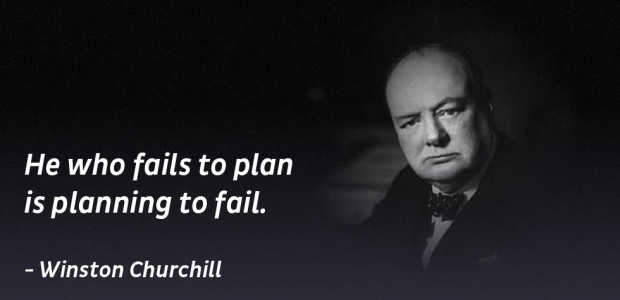Without Workforce Planning and Analytics, You’re “Planning to Fail”

There’s a popular business adage – often attributed to Winston Churchill – that goes like this: “he who fails to plan is planning to fail.”
I couldn’t agree more. In fact, 95 percent of organizations that conduct long-range planning (looking ahead five to 15 years down the road) are likely to outperform those which don’t, according to research from Gartner. In addition, one-half of underperforming organizations do not engage in long-term planning.
This applies, of course, to workforce planning. According to Wikipedia, workforce planning is defined as a continual process used to align the needs and priorities of an organization with those of its workforce to ensure it meets its legislative, regulatory, service and production requirements and strategic objectives. However, organizations frequently struggle here as well: nearly one-half of HR leaders say, at best, it is only “partly true” that they have developed a clear linkage between their workforce strategy/plan and a strategic business plan, according to research from KPMG. Seven of ten say the same about the ability of their workforce strategy/plan to provide needed information to “sound people making decisions.” And just 27 percent said the process for developing their workforce strategy/plan is uniformly well-structured and effective.
Unfortunately, HR departments typically take part in activities “which don‘t address broader strategic workforce issues, including how the workforce strategy (if there is one) is aligned with the business strategy,” according to KPMG’s resulting “Workforce Strategy Audit Survey Report.” “Employees now come in all shapes and sizes – permanent, casual, part-time, contractor, consultant, to name but a few. The workforce has also become more mobile and diverse. Managing this increasingly complex workforce requires a more sophisticated and differentiated approach than most organizations have been used to.”

For years, Acendre has collaborated closely with HR teams to help them align long-term workforce planning with business objectives, so human capital strategies support “big picture” goals in finding, attracting, hiring and developing talent. And, time after time, we’ve proven to them that they can’t successfully proceed here without modern analytics solutions. You need, after all, the precise forecasting and analysis of data relating to both quantitative (employee ages, gender breakdowns and other demographics, along with salary/tenure/experience histories) and qualitative (staffers’ competencies/performance ratings, training/development participation, successional status, flight-risk potential, career aspirations and retirement eligibility) factors to execute a winning plan.
Indeed, without strong analytics capabilities driving your efforts, you’re “planning to fail” in essential areas such as these:
Competency mapping. Analytics allows you to identify – for today, tomorrow and many years from now – what core competencies are required to accomplish strategic goals and whether existing talent can meet the challenge. These solutions can tell you where your human capital is exceeding expectations and where it’s falling short, paving the way for new allocations of “people” resources and “best practices” sharing that ensure lasting, positive improvements. At the same time, you can build a database that constantly tracks which training/development programs produce the most impactful, measurable results, and expand them to address lingering shortcomings in personnel capabilities.
Budget execution. Sophisticated analytics can provide your executive leadership teams with insight into current and projected budget allocation overlaid with planned hiring and attrition totals. This allows you to stay on top of developing trends and any new factors so you can make the necessary adjustments to keep on plan.
Engagement initiatives. Numerous studies have documented the benefits of employee engagement. To cite just one, Gallup has found that engaged professionals are 27 percent more likely than their counterparts to do excellent work and 45 percent more adaptable in light of change – the latter being a highly sought trait in long-term strategic planning. They also miss 70 percent fewer days due to poor health and are 59 percent less likely to look for a job with a different employer over the next year.
Again, analytics can provide a major boost here, so you can evaluate (through in-depth breakdowns of satisfaction surveys) which areas/departments benefit from high engagement and which do not. Then, you pursue revealing “storylines” within the data, to determine what successful units are doing right. Perhaps they’re better at proactively recognizing strong performances/staff contributions year-round, instead of waiting for an annual review. Or they may do a superior job of communicating to their teams how individual roles support the overall organizational mission. Or they could more aggressively incorporate training/development and career advancement into their culture. Whatever you find through analytics, you can apply the “success secrets” of highly engaged areas to other units, organization-wide.
Retirement/succession management. As I’ve frequently reported here, organizations of all kinds must prepare for a retirement “tsunami.” Baby boomers are already leaving in droves – and you can’t wait for their going-away parties to think about replacing them. Thanks to analytics, you embed retirement/succession management into a lasting workforce planning architecture, always staying on top of which staffers are likely to retire next month, next year or a decade from now. Then, you tap into analytics to scout for succession candidates, and start grooming them to fill these positions well before they open up.
We’re all dealing with the rapid page of change today, which means your workforce planning efforts should position your organization to respond accordingly with velocity and agility. Through analytics, you can exhaustively examine the present and past to anticipate the future, and make the best decisions to prepare for it — leading to what someone like Churchill would describe as your HR department’s “finest hours.”
By following this course, talent-management leaders can ascend to this level of strategic influence.
Follow Joe Abusamra on Twitter - @JoeAbusamra
Follow Acendre on Twitter - @AcendreTalent
Back To List